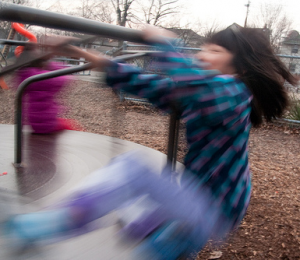In NYC, Pop-Up Playgrounds Get Kids Physically Active

 The prevalence of obesity in United States children has reached epidemic proportions. The most recent national estimates suggest that the prevalence of at-risk-for-overweight continues to remain alarmingly high, with no signs of decreasing. Currently, 31.0% of children 6 to 11 years of age are estimated to be at-risk-for-overweight or obesity, and 16.0% are estimated to be overweight. From a public health perspective, childhood obesity is also particularly concerning because it has been documented that obesity in childhood tracks into adulthood and leads to premature death.
The prevalence of obesity in United States children has reached epidemic proportions. The most recent national estimates suggest that the prevalence of at-risk-for-overweight continues to remain alarmingly high, with no signs of decreasing. Currently, 31.0% of children 6 to 11 years of age are estimated to be at-risk-for-overweight or obesity, and 16.0% are estimated to be overweight. From a public health perspective, childhood obesity is also particularly concerning because it has been documented that obesity in childhood tracks into adulthood and leads to premature death.
The current obesity epidemic is even more pronounced in minority children and children with low socioeconomic status, likely the result of poor food choices and decreased opportunity for physical activity.
One of the challenges when combating obesity in low-income neighborhoods is that the urban environment can discourage children from being active. According to the advocacy group Transportation Alternatives, which has long been concerned with the character of New York’s streets, high crime rates and heavy truck traffic often make such streets unsuitable for play. Local parks too often lack simple amenities like spray showers.
More generally, the habits born of living in these environments can create a vicious cycle in which children become more and more accustomed to staying inside and watching TV or playing video games. New York City is now doing something to promote physical activity in some of its most disadvantaged neighborhoods.
During a two-month period last year, seven civic coalitions in New York neighborhoods like East Harlem and the South Bronx got permits from the city to close certain local streets to traffic for designated periods of time. Working with the police and other city agencies, they re-designated the areas as temporary “play streets,” encouraging neighborhood children to use them for exercise and offering a range of free games, athletic activities and coaching.
They call them “pop-up” playgrounds.
Data collected from the sites indicates that families visited local play streets for one to two and a half hours on average — time that many would have otherwise spent inside, according to a majority of the parents surveyed. This was a resounding success!
Encouraged by last year’s results this summer the city is running 12 pop-up playgrounds, which offer instruction in activities as varied as yoga, running, tennis, rugby and jump-rope. All the sites are in low-income neighborhoods with high rates of childhood obesity.
Hopefully this idea will be implemented in urban communities across the country. Julia De Martini Day, who works on health issues for Transportation Alternatives, says that a new survey this year aims to link the success of the play streets to campaigns to pressure lawmakers to make land-use changes in these neighborhoods, be they better street lighting, more park benches, designated bike lanes — or even permanent play streets.
Get involved in your community to encourage physical activity. Contact Transportation Alternatives for more information. Healthy habits can become a vicious cycle that will lead to healthy lifestyles.
[Photo By stevendepolo]
